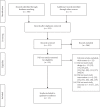Overview of "Systematic Reviews" of the Built Environment's Effects on Mental Health
- PMID: 32256618
- PMCID: PMC7106933
- DOI: 10.1155/2020/9523127
Overview of "Systematic Reviews" of the Built Environment's Effects on Mental Health
Abstract
Good mental health is related to mental and psychological well-being, and there is growing interest in the potential role of the built environment on mental health, yet the evidence base underpinning the direct or indirect effects of the built environment is not fully clear. The aim of this overview is to assess the effect of the built environment on mental health-related outcomes. Methods. This study provides an overview of published systematic reviews (SRs) that assess the effect of the built environment on mental health. We reported the overview according to the Preferred Reporting Items for Systematic Reviews and Meta-Analyses (PRISMA) guidelines. Databases searched until November 2019 included the Cochrane Database of Systematic Reviews, EMBASE, MEDLINE (OVID 1946 to present), LILACS, and PsycINFO. Two authors independently selected reviews, extracted data, and assessed the methodological quality of included reviews using the Assessing Methodological Quality of Systematic Reviews-2 (AMSTAR-2). Results. In total, 357 records were identified from a structured search of five databases combined with the references of the included studies, and eleven SRs were included in the narrative synthesis. Outcomes included mental health and well-being, depression and stress, and psychological distress. According to AMSTAR-2 scores, the quality assessment of the included SRs was categorized as "high" in two SRs and as "critically low" in nine SRs. According to the conclusions of the SRs reported by the authors, only one SR reported a "beneficial" effect on mental health and well-being outcomes. Conclusion. There was insufficient evidence to make firm conclusions on the effects of built environment interventions on mental health outcomes (well-being, depression and stress, and psychological distress). The evidence collected reported high heterogeneity (outcomes and measures) and a moderate- to low-quality assessment among the included SRs.
Copyright © 2020 Solange Núñez-González et al.
Conflict of interest statement
The authors declare that there are no conflicts of interest regarding the publication of this paper.
Figures
Similar articles
-
Reporting and Methodological Quality of Systematic Reviews and Meta-Analyses of Nursing Interventions in Patients With Alzheimer's Disease: General Implications of the Findings.J Nurs Scholarsh. 2019 May;51(3):308-316. doi: 10.1111/jnu.12462. Epub 2019 Feb 25. J Nurs Scholarsh. 2019. PMID: 30806019
-
Abstract analysis method facilitates filtering low-methodological quality and high-bias risk systematic reviews on psoriasis interventions.BMC Med Res Methodol. 2017 Dec 29;17(1):180. doi: 10.1186/s12874-017-0460-z. BMC Med Res Methodol. 2017. PMID: 29284417 Free PMC article.
-
Systematic review adherence to methodological or reporting quality.Syst Rev. 2017 Jul 19;6(1):131. doi: 10.1186/s13643-017-0527-2. Syst Rev. 2017. PMID: 28720117 Free PMC article.
-
A systematic review of the quality of distal radius systematic reviews: Methodology and reporting assessment.PLoS One. 2019 Jan 23;14(1):e0206895. doi: 10.1371/journal.pone.0206895. eCollection 2019. PLoS One. 2019. PMID: 30673700 Free PMC article.
-
Effectiveness and Safety of Acupuncture for Migraine: An Overview of Systematic Reviews.Pain Res Manag. 2020 Mar 23;2020:3825617. doi: 10.1155/2020/3825617. eCollection 2020. Pain Res Manag. 2020. PMID: 32269669 Free PMC article. Review.
Cited by
-
COVID-19 lockdown impact on familial relationships and mental health in a large representative sample of Italian adults.Soc Psychiatry Psychiatr Epidemiol. 2022 Aug;57(8):1543-1555. doi: 10.1007/s00127-022-02273-3. Epub 2022 Mar 28. Soc Psychiatry Psychiatr Epidemiol. 2022. PMID: 35347348 Free PMC article.
-
Factors influencing the effectiveness of nature-based interventions (NBIs) aimed at improving mental health and wellbeing: Protocol of an umbrella review.PLoS One. 2023 Jul 21;18(7):e0273139. doi: 10.1371/journal.pone.0273139. eCollection 2023. PLoS One. 2023. PMID: 37478105 Free PMC article.
-
Mental Health in Urban Environments: Uncovering the Black Box of Person-Place Interactions Requires Interdisciplinary Approaches.JMIR Mhealth Uhealth. 2023 May 11;11:e41345. doi: 10.2196/41345. JMIR Mhealth Uhealth. 2023. PMID: 37166963 Free PMC article.
-
COVID-19 lockdown impact on mental health in a large representative sample of Italian adults.J Affect Disord. 2021 Sep 1;292:398-404. doi: 10.1016/j.jad.2021.05.117. Epub 2021 Jun 4. J Affect Disord. 2021. PMID: 34139414 Free PMC article.
-
Do social isolation and neighborhood walkability influence relationships between COVID-19 experiences and wellbeing in predominantly Black urban areas?Landsc Urban Plan. 2022 Jan;217:104264. doi: 10.1016/j.landurbplan.2021.104264. Epub 2021 Oct 7. Landsc Urban Plan. 2022. PMID: 34690393 Free PMC article.
References
-
- World Health Organization. Promoting mental health concepts emerging evidence practice summary report. 2004. https://www.who.int/mental_health/evidence/en/promoting_mhh.pdf.
-
- World Health Organization. The world health report: mental health: new understanding, new hope. 2001. https://www.who.int/whr/2001/en/whr01_en.pdf?ua=1.
-
- World Health Organization. mhGAP operations manual mental health gap action programme. 2018. https://apps.who.int/iris/bitstream/handle/10665/275386/9789241514811-en....
Publication types
MeSH terms
LinkOut - more resources
Full Text Sources
Medical
Research Materials


